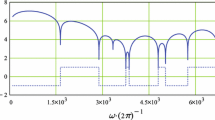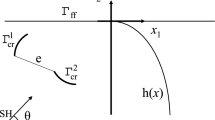Abstract
In the past years, a numerical technique method called Variational Theory of Complex Rays (VTCR) has been developed for vibration problems in medium frequency. It is a Trefftz Discontinuous Galerkin method which uses plane wave functions as shape functions. However this method is only well developed in homogeneous case. In this paper, VTCR is extended to the heterogeneous Helmholtz problem by creating a new base of shape functions. Numerical examples give a scope of the performances of such an extension of VTCR.













Similar content being viewed by others
References
Strouboulis T, Hidajat R (2006) Partition of unity method for Helmholtz equation: q-convergence for plane-wave and wave-band local bases. Appl Math 51:181–204
Cessenat O, Despres B (1998) Application of an ultra weak variational formulation of elliptic PDEs to the two-dimensional Helmholtz problem. SIAM J Numer Anal 35:255–299
Gabard G, Gamallo P, Huttunen T (2011) A comparison of wave-based discontinuous Galerkin, ultra-weak and least-square methods for wave problems. Int J Numer Methods Eng 85:380–402
Gittelson CJ, Hiptmair R, Perugia I (2009) Plane wave discontinuous Galerkin methods: analysis of the h-version. ESAIM Math Model Numer Anal 43:297–331
Barnett A, Betcke T (2008) Stability and convergence of the method of fundamental solutions for Helmholtz problems on analytic domains. J Comput Phys 227:7003–7026
Farhat C, Harari I, Franca L (2001) The discontinuous enrichment method. Comput Methods Appl Mech Eng 190:6455–6479
Desmet W, Sas P, Vandepitte D (2001) An indirect Trefftz method for the steady-state dynamic analysis of coupled vibro-acoustic systems. Comput Assist Mech Eng Sci 8:271–288
Tezaur R, Kalashnikova I, Farhat C (2014) The discontinuous enrichment method for medium-frequency Helmholtz problems with a spatially variable wavenumber. Comput Methods Appl Mech Eng 268:126–140
Ladevèze P (1996) A new computational approach for structure vibrations in the medium frequency range. C R Acad Sci Paris 332:849–856
Rouch P, Ladevèze P (2003) The variational theory of complex rays: a predictive tool for medium-frequency vibrations. Comput Methods Appl Mech Eng 192:3301–3315
Ladevèze P, Blanc L, Rouch P, Blanzé C (2003) A multiscale computational method for medium-frequency vibrations of assemblies of heterogeneous plates. Comput Struct 81:1267–1276
Riou H, Ladevèze P, Rouch P (2004) Extension of the variational theory of complex rays to shells for medium-frequency vibrations. Sound Vib 272:341–360
Riou H, Ladevèze P, Sourcis B (2008) The multiscale VTCR approach applied to acoustics problems. Comput Acoust 16:487–505
Kovalevsky L, Riou H, Ladevèze P (2013) On the use of the variational theory of complex rays for the analysis of 2-D exterior Helmholtz problem in an unbounded domain. J Wave Motion 50:428–436
Ladevèze P, Riou H (2014) On Trefftz and weak Trefftz discontinuous Galerkin approaches for medium-frequency acoustics. Comput Methods Appl Mech Eng 278:729–743
Polyanin AD, Zaitsev VF (2002) Handbook of exact solutions for ordinary differential equations. CRC Press
Modesto D, Zlotnik S, Huerta A (2015) Proper generalized decomposition for parameterized Helmholtz problems in heterogeneous and unbounded domains: application to harbor agitation. Comput Methods Appl Mech Eng 295:127–149
Berenger JP (1994) A perfectly matched layer for the absorption of electromagnetic waves. J Comput Phys 114:185–200
Givoli D (2004) High-order local non-reflecting boundary conditions: a review. J Wave Motion 39:319–326
Bayliss A, Turkel E (1980) Radiation boundary conditions for wave like equations. Commun Pure Appl Math 33:707–725
Antoine X, Barucq H, Bendali A (1999) Bayliss Turkel-like radiation conditions on surfaces of arbitrary shape. J Math Anal Appl 229:184–211
Givoli D (1999) Recent advances in the DtN FE method. Arch. Comput. Methods Eng. 6:71–116
Herrera I (1984) Boundary methods: an algebraic theory. Pitman Advanced Publishing Program, Boston
Author information
Authors and Affiliations
Corresponding author
Rights and permissions
About this article
Cite this article
Li, H., Ladeveze, P. & Riou, H. Extended variational theory of complex rays in heterogeneous Helmholtz problem. Comput Mech 59, 909–918 (2017). https://doi.org/10.1007/s00466-017-1385-4
Received:
Accepted:
Published:
Issue Date:
DOI: https://doi.org/10.1007/s00466-017-1385-4




